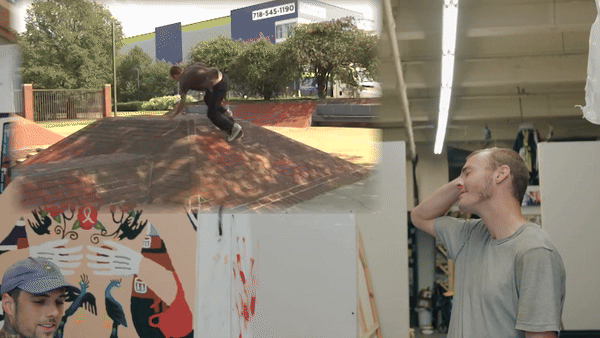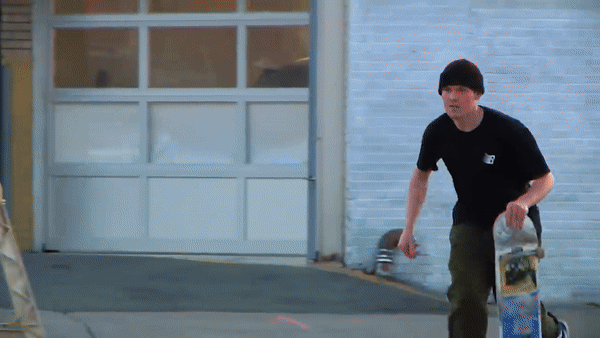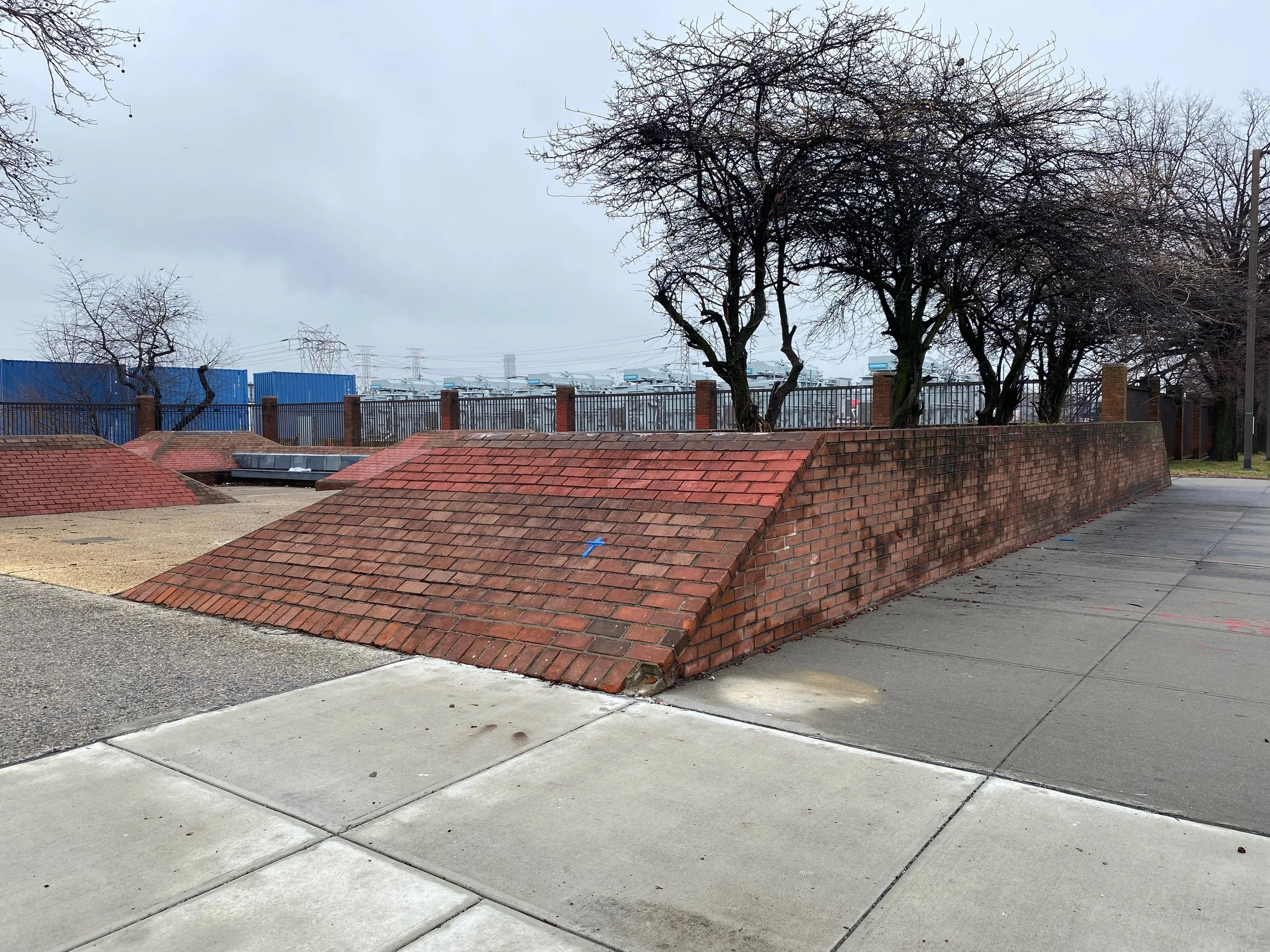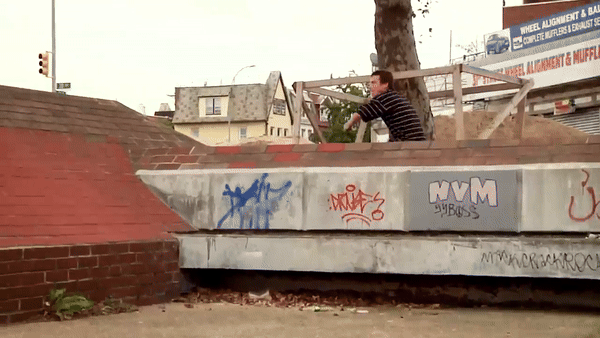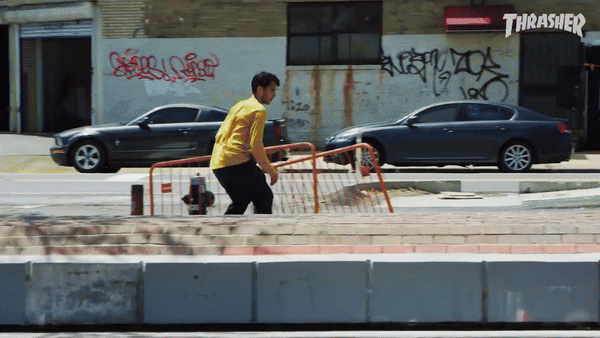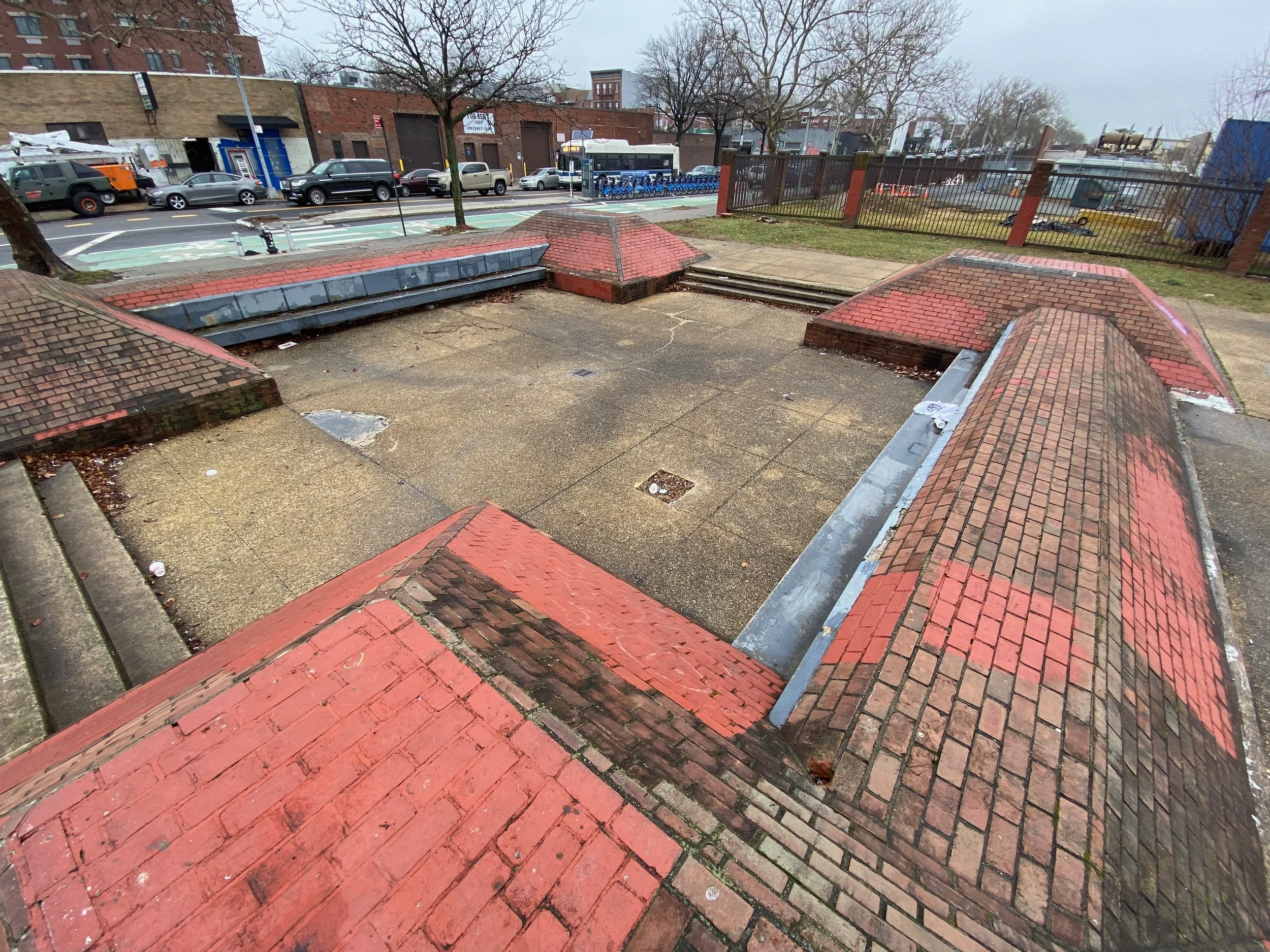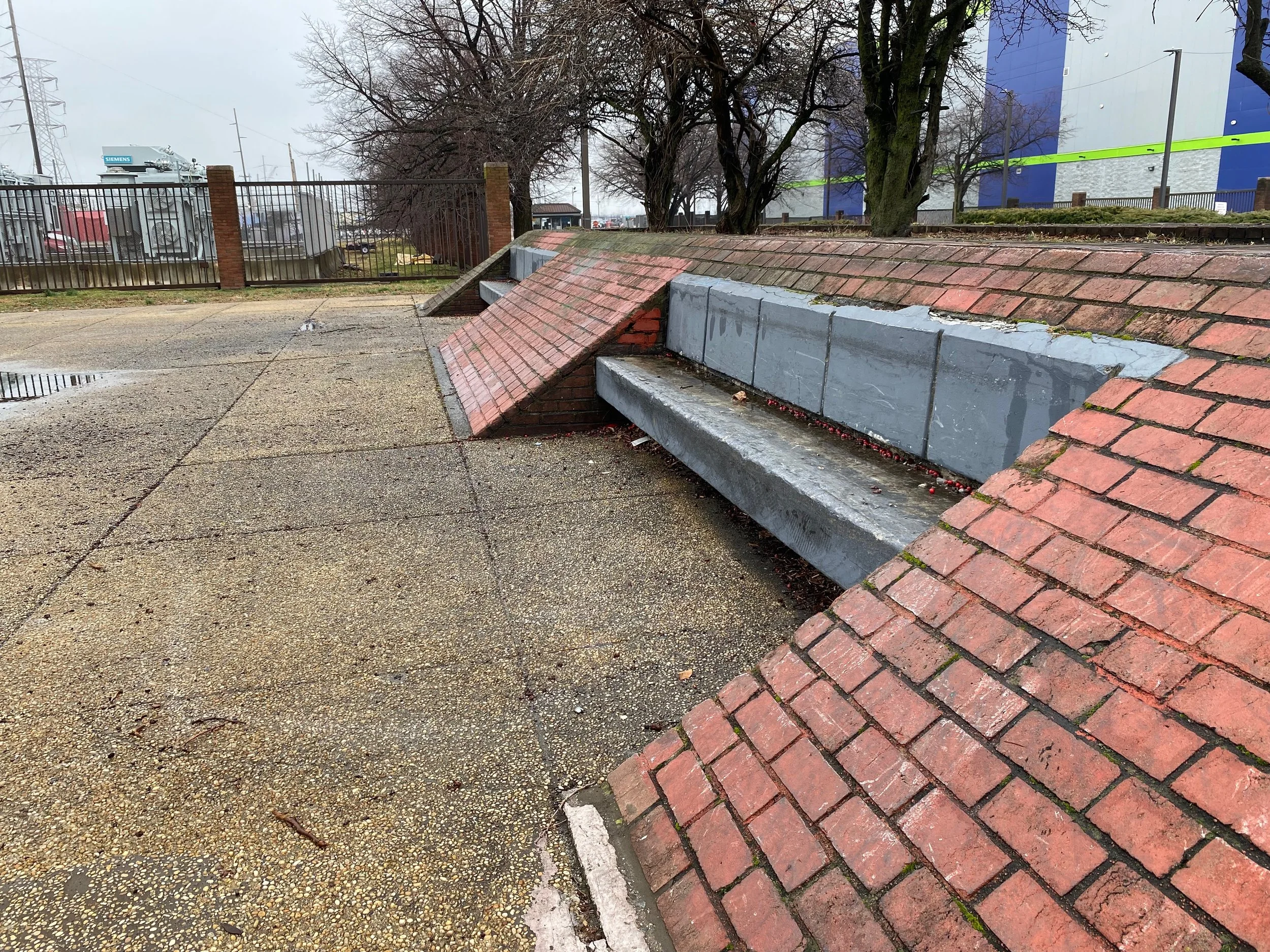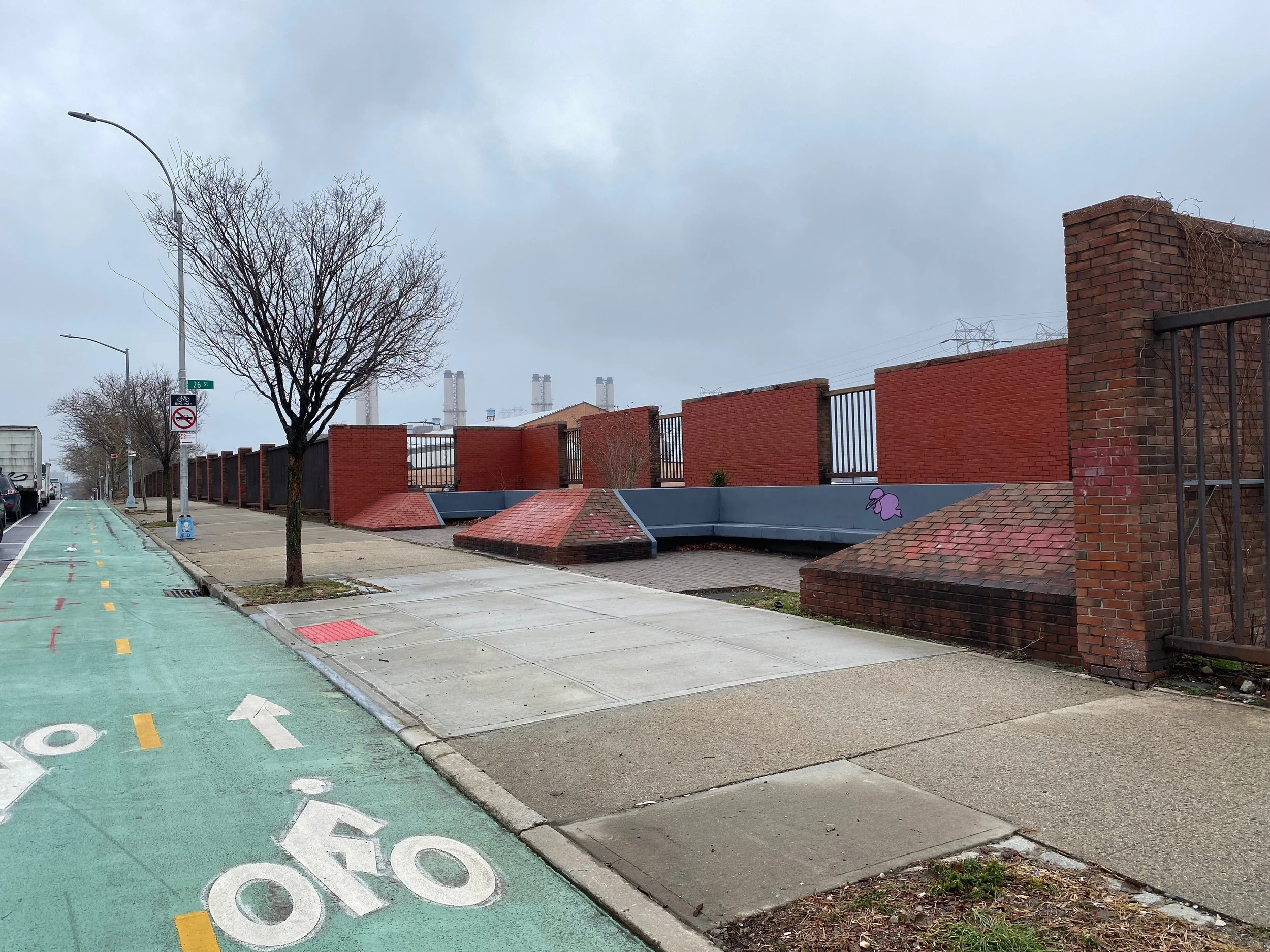Con Edison Banks: A History
Max Palmer. Skate Jawn, Do Dummies Dream of Electric Bricks?
Words by Jeff Haber
The place we’ve come to call the Con Edison Banks is, as you may know, a famous skateboard spot located just outside the entrance to New York City's largest power plant facility at 31st St and 20th Ave in Astoria, Queens. The roughly 300-acre property, now occupied by Con Edison and other energy companies, is completely fenced off and private. Outside the fence is the plaza with the skate spot, which is accessible to the public, though it is within the boundary of ConEd's land.
It appears that the plaza is meant for pedestrians to use – It abuts the sidewalk that runs east to west on the north side of 20th Avenue, and there is no gate to prevent entry. The average person might find it suitable as a temporary place to rest, eat lunch, or have a conversation. The plaza has seating for about 30 people and the same number could stand or stroll around in it. As plazas go, this place is comparatively small in size, made of uncomfortable materials, and is not very inviting. Visitors are limited to viewing vehicular traffic, a bus stop, a wheel alignment shop, a gas station, and a storage facility. The surrounding area is entirely industrial.
Since the early 1980s, the plaza has primarily functioned as a skate spot. The earliest evidence of the plaza's importance to skateboarding can be heard in the hardcore band Kraut's song about skating there, Pyramids, which was recorded in 1984 on their album Whetting the Scythe. The song begins with the words, "Do your best to stay on top / vertical, that's a lot." And, in a 2016 No Echo interview, Gorilla Biscuits bassist Arthur Smilios spoke about skating the spot in 1986 or 1987, and how it was the place where the band formed:
“One night, while hanging out skateboarding at the Pyramids (an Astoria skate spot; essentially a set of truncated pyramids - hence the name - at the entrance to the Con Edison plant on 31st Street and 20th Avenue), Bad Religion was playing on the boombox. Civ (Anthony Civarelli) was singing along with We're Only Gonna Die and Ernie of Token Entry had the idea for him to do vocals for this as-yet-unnamed project because his voice was/is beautiful.”
Mark Humienik, frontside tailslide, kickflip out. PTSD by Bronze Hardware.
I reached out to Civ (the lead singer of Gorilla Biscuits) on Instagram and asked if he could share with me what he knew about the history of the Pyramids. He said I should ask Ernie Parada of Token Entry because he "hung out there a lot." So I messaged Ernie and he said, "I've been waiting forever for someone to ask me that. I am the only person that can tell you that story."
According to Ernie, in the summer of 1980 he and a classmate of his named Patrick Burns were skating in the courtyard of Burns' building in Astoria. He suddenly asked Ernie "Did you ever take it down to the Pyramids?" He hadn't. They went to the spot and Ernie watched Patrick ride up the side of one of the banks, do a kickturn, and come down without falling. "It was magic. It was glorious. I had never seen anything like it." What's more, he did this unprecedented maneuver with a board that "was tiny with trucks bolted at the very ends leaving virtually no nose and no tail." Ernie credits Patrick Burns as the "person who first conceived the idea" of skating the Pyramids. He then told his other friend Johnny Feedback (the drummer of Kraut) who was into skateboarding and took him there. "Then it caught fire. That's how it all started. Patrick Burns to me to Johnny Feedback to the world," said Ernie.
He further explained that to his knowledge the spot was the only place in Queens where skateboarding was happening in the early 1980s. The location's importance to skateboarding is intertwined with the New York Hardcore (NYHC) music scene. Gilligan's Revenge, Token Entry, Kraut, Murphy's Law, the Mob, Gorilla Biscuits, NY Hoods, and more all congregated at the Pyramids. The bands The Faction and JFA showed up there at least once. Russell Iglay of Murphy's Law and later Underdog was one of the better skaters, along with Tim Chunks and Jon Soto (a Long Islander).
Interestingly, Ernie said the skaters in the 80’s actually rode the plaza that used to be on the east side of the entrance to the plant, which was a mirror-image of the one still standing, where the storage facility is now. "We used to line up on the half pyramid (this is the one that's up against the street that leads into the power plant) and drop in to come up the other side. Russ used to run follow-the-leader lines that would go all over the place."
The spot earned the name the Pyramids, and later the ConEd Banks, because it possesses undeniably unique architectural elements. Namely, four brick pyramids with embankments that are flush with the ground. These pyramids are technically built in the style of what is known as a "truncated square frustum." A commonly-known example of this type of pyramid with the top cut off can be seen on the backside of a $1 dollar bill.
The ConEd Banks consists of four pyramid-shaped embankment structures made of red brick - this encompasses ¾ of the entire plaza. Each pyramid has four side faces and they are arranged in a large square layout, with a pyramid at each corner of the square. The ground surface consists of a resin-bound gravel, which is very rough. The pyramids are connected east to west with a smaller, lengthier bank, on both the top and bottom of the square. There is also a subterranean square inside the layout, which you enter by descending three stairs. Within the interior are two concrete benches that face each other.
The remaining ¼ of the plaza at the easternmost side is taken up by a more rectangular embankment structure. It is the exact same size, north to south, as the pyramid-square section. This rectangular structure has embankments at the top and bottom end and on the left side, which are all flush with the ground. It also has two of the same concrete benches built into it. These benches are separated by a long bank in the middle and two skinner ones at each end. On top of the rectangular structure is a planter with four medium-sized trees.
Whatever the design intention was, the layout and architectural elements make this plaza very intriguing to skateboarders. Relatively speaking, the brick embankments are somewhat of a perfect wave, if the attraction of a skate spot can be traced back to the surfer-origins of the activity. Also, a ledge between two banks that are flush to the ground is basically unheard of in terms of street spots. Obviously, street skateboarders can enjoy various kinds of obstacles in the found environment, but embankments are among the most attractive because they are rare, especially in NYC.
Emile Laurent, frontside kickflip. Polar, Sounds Like You Guys Are Crushing It
To expand on that rarity, the ConEd Banks are not underneath a highway overpass or in any way connected to a highway road system, which is where these features are more typically found, if at all. One could argue that this spot does not measure up to the more famous Brooklyn Banks in Lower Manhattan, concerning brick waves and their sidewalk-surfability. But, I would suggest the ConEd Banks present a wider range of creative options as a result of the architecture. A given skater's straight-forward skill at this place is not as relevant as their ability to interpret the design of the plaza.
Even though from a design perspective the pyramids are theoretically perfect or akin to structures built at skateparks, the spot is extremely difficult to skate. Its reputation in modern skate culture is synonymous with the difficulty factor. The resin-bound surface of the ground is what presents the most resistance because of its impermeability. When you skate on the ground you glide across a composite of many tiny pebbles glued together, which leads to a slickness that simultaneously, and almost immediately, eats all speed.
Zak Anders, bluntslide to fakie. Chase Walker, PLAY TIME.
Whatever approach a skater takes at the ConEd Banks, they need to generate as much speed as possible. Logistically, gaining that speed is complicated. If you start across the road with two-way traffic you need to gauge the flow of vehicles based on busyness or the traffic light. An approach from 31st Street has one advantage in that it is downhill toward the obstacles, but that option limits which obstacles can be hit, as well as the the angle of approach. Meanwhile, if you start in the bike lane you are contending with the sticky, graded green surface meant for inflated tires. If you begin on the sidewalk, you'll encounter numerous cracks and the unevenness of the pavement, as well as branches and other industrial area debris. Starting within the plaza means you are limited to a sprint-and-throw-down or a medium-speed drop in, with maybe one or two pushes before execution. All in all, nothing about the approach, regardless of which obstacle you are skating, is easy.
The speed factor and the overall roughness of the spot deters many skaters, seasoned and novice alike, from actually skating here. Swapping out harder wheels with cruiser wheels that have a lower durometer can be beneficial because they increase grippiness. For those interested in blasting airs, this can be a good choice. At the same time, a softer wheel will prevent skaters from being able to do any type of slide grinds on the tops of the pyramids or on the benches. Trick selection, energy level, and willingness are all part of how a skater approaches the ConEd Banks. Indeed, those ingredients are mixed together for any skate session anywhere, but at this spot skaters need to be very deliberate and calculating to find success, particularly for tricks that haven't been done before (NBDs). One of the greatest benefits of the spot is that you can expect to skate it as long as you like. No one is likely to kick you out, be it neighboring business owners, local residents, ConEd employees, or police. Therefore, if you have the drive, the commitment, and the creativity you can express yourself for an indefinite amount of time.
In the early years of its existence, as noted earlier, the plaza served a more traditional purpose by encouraging congregation and community building. More recently, meaning at least since the early 2000s when the spot started to appear in skate videos, skaters by-and-large journey here to prove themselves by way of an individual challenge. In my opinion, the pyramid elements, the out-of-the-way location, and the current isolated culture of the plaza make this spot reminiscent of a religious site.
Tom Knox, noseblunt into backsie 50-50. Dickies, Another Day, Another Bodega
One of my goals in writing about the ConEd Banks was to determine its history within the context of NYC, outside of skateboarding. To compare whatever the design intention might have been with the unintended usage by skaters. As it turns out, finding any direct information about the plaza proved to be as difficult as skating it.
First, I sent an email to the press department at ConEd inquiring about the architect and the construction year. They never replied, even after a follow up email. Then, I contacted the Reference desk at the City College of New York library. I got in touch with John Drobnicki, a Professor in the Library Department at York College. He pointed out that the land has been owned and/or leased by several companies, and suggested that the plaza was probably built by Con Edison, the New York Power Authority, or the Charles Poletti Power Project. He noted that I should try to figure out who owns the property where the plaza sits and reach out to them to inquire about the design and construction. He then recommended I contact the Greater Astoria Historical Society and the Queens Public Library's (QPL) Central branch. I emailed the society and corresponded with Bob Singleton. He was very nice and offered a few leads, but he could not provide any information on the plaza. The Archivist at QPL said they wouldn't have anything on the plaza and that I should contact the Municipal Archives - I did and they said they don't keep any records for Queens.
However, I ran a search on the NYC Records & Information Services Library catalog and saw that there was a book in the Municipal Archives titled Report on the Expansion of the Astoria Plant, published in 1970 by Milton Musicus and Jerome Kretchmer. I Googled Kretchmer and found that he served as the city's Environmental Protection Administrator for a few years in the early 1970s. The New York Times published a bunch of articles covering Kretchmer's opposition to the Astoria plant expansion, due to health and environmental concerns. He coined the term "Asthma Alley" in reference to the then 10 power plants that lined the East River, which led to unusually high rates of asthma and other respiratory illnesses among city residents, notably in Astoria. The Nature Journal published an article about the expansion project and wrote, "Astoria is recognized as the most polluted area in the country." Mayor John Lindsay, according to the Times and Nature, was initially opposed to the project, but ultimately permitted ConEd to proceed. ConEd wanted to build a new 1,600 Megawatt electricity generator plant using low-sulfur petroleum or natural gas if supplies were available. Lindsay agreed to permit ConEd to install half that generating capacity. Kretchmer and the community opposed the plant because of increased pollution that caused illness, including premature fatalities that resulted from sulfur dioxide poisoning.
Having read up on this story, I then did more Googling and found the 1974 Power Authority of the State of New York Annual Report. This report states the Authority (NYPA) purchased "a partially completed 826,575 kw fossil-fuel generating plant and related facilities, known as Astoria 6, and previously owned by Con Edison," which was enabled by legislation and cost $100,000,000. Astoria 6 (also called Astoria Unit 6 or Unit 6) is the NYPA name for the original ConEd expansion project. Later, once the power station was completed and generating electricity, it was renamed the Charles Poletti Power Project after the politician. In 2010, the Poletti plant was shut down by community and political efforts, spearheaded by Senator Michael Gianaris, former Council Member Peter Vallone, Jr., and a group named CHOKE. Incidentally, in the same year, Mr. Vallone, Jr., was responsible for the creation of Astoria Skatepark, the 21,500 square-foot concrete oasis in Astoria Park. The skatepark has made the area's skate scene more vibrant and essentially replaced the ConEd Banks as the go-to spot in the neighborhood.
Pat Gallaher, backside 50-50 frontside flip out. Pete Spooner, Skating is Easy.
I happen to be acquainted with Mr. Vallone Jr., aka Pete, because he's my neighbor. In 2022, I was randomly the victim of a pellet gun drive-by outside his house while walking my dogs. During the two-hour wait for the NYPD to show up, Pete kindly chatted with me and his other neighbors and then we exchanged numbers. When writing this story I texted him to ask if he knew anything about the ConEd Banks. He didn't, but he did say, "the skatepark is one of my proudest accomplishments!" Pete also gave me the backstory about how the skatepark ended up underneath the Triboro Bridge. According to Vallone, he had been trying to find a location for the park for years, but kept running into neighborhood opposition. Then he noticed that the plot under the bridge was "taken up by old construction equipment behind a big fence for years and wondered why." The land was leased for that purpose, but the lease was up, and he deemed it the safest, most sensible location. He still faced opposition from folks on 19th Street, which runs parallel to Astoria Park, but he went forward anyway. "An awesome side note," Pete told me, "the leaders of the opposition came to me a year later [2011] and said 'You were right,' which probably never happened to me before or after in public service."
ConEd's lack of response and the elimination of the Poletti plant meant that the only remaining entity that would have some record of the plaza would be the NYPA. In 2021, I randomly spoke to a local resident near ConEd who told me the Pyramids were built in the 1970s as part of what he described as a beautification program. Given that the Astoria 6 expansion effort was started in the same decade, I had a hunch that the Pyramids were probably built between 1970 and 1974. I sent an email to Maura Balaban, who handles communications at the NYPA. I relayed that I believed the plaza was constructed as part of the ConEd expansion project and asked if she could help me identify the architect and the year it was built. She forwarded the inquiry to the NYPA Records Department, which reported that the Acquisition Agreement of Astoria 6 in 1974 references a contract and purchase order with a company called Ingram & Greene, Inc. to build a "mini park & new fence," dated November 6, 1972. Additionally, they stated "records show that Ebasco Services was the 'Architect/Engineer' for the project." The NYPA Annual Report confirms this information, "Unit 6 was engineered and designed by Ebasco Services, Inc. under the overall direction of Con Edison." Ingram & Greene was a firm that handled concrete foundation construction in New York, though I couldn't find their last-known address. Ebasco Services was a multi-million-dollar company based in the United States that designed and constructed energy infrastructure around the world, including a number of nuclear power plants that are still standing today.
For further context, I called former Environmental Protection Administrator Jerome Kretchmer, who is now 89-years-old, and asked him about the Astoria expansion project. He admitted he did not recall anything related to the plaza, but was willing to discuss the time period in which it was constructed.
Was the reason for the expansion a power crisis or just greed?
It was 50/50. There were very few times when there wasn't enough power. There has been more of that more recently. Remember, by 71 or 72, there wasn't the number of air conditioners, no computers - so demand was nowhere near [what it is now].
Why did the mayor ultimately approve the project even though it was so opposed?
Because they [(ConEd)] were stronger than I was. If you're the Environmental Protection Administrator, it's pretty easy to have a position and maintain that position. If you're the mayor and everybody is banging you around and you have to worry about whether the city's going to have enough electricity, you might not be able to support that decision. He [(Mayor Lindsay)] never stopped me from saying what I wanted to say, though. He did what he had to do, and I did what I had to do, and to this day I believe that those plants were a mess. And there was really no way at the time of dealing with the environmental output from the generators. There are some options today, I guess, but there weren't any then, so there was no such thing as clean electricity when the source was coal-burning generators.
The smaller plaza at 26th street.
Was the plaza, now known as the ConEd Banks in skateboarding culture, built as a sort of gift from the evil power company to the community of Astoria? Probably. An August 1, 1970 article in The New York Times, titled "Con Ed's Plans for Astoria Opposed by Kretchmer," describes how my neighbor Pete's father, Peter Vallone, then Executive Chairman of the Astoria Civic Association, represented the community's opposition to the expansion. Not only did they try to convince the community of the energy-based need for the project, ConEd also "backed up its explanations with some promises of civic improvements…the company pledged to construct for community use a sports complex on a vacant portion of the utility property; two small parks, one of them along the East River waterfront, and a new 20-block-long fence, which would be 'esthetically pleasing.'" In addition to the main plaza at the plant's entrance, there is also an even smaller one on 20th Avenue at 26th Street, with similar features (not at the waterfront), but the banks are not flush with the ground.
The ConEd Banks sit quietly near the entrance to a mysterious 300-acre parcel of land that has been a site of energy, pollution, and controversy for over 100 years. Whatever the intention of the design, the plaza was built during a very tumultuous period in NYC's power history. I would guess that neither Ebasco Services nor the contractor Ingram & Green knew that what they built would become an iconic skate spot, due to its unique brick pyramid-embankment features. Perhaps ConEd originally wanted to attract the community of Astoria to use the plaza to sit, chat, or walk around and be aesthetically pleased in the shadow of a power plant that might kill them. Be that as it may, the unintended use and purpose of the ConEd Banks has been overwhelmingly as a skate spot, and it has drawn local, national, and international skaters for the last 40 years because of its sustainable uniqueness.

